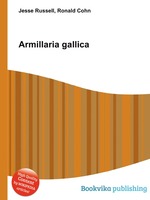Armillaria gallica
Jesse Russell Ronald Cohn
бумажная книга
High Quality Content by WIKIPEDIA articles! Armillaria gallica (synonymous with A. bulbosa and A. lutea) is a species of honey mushroom in the Physalacriaceae family of the Agaricales order. The species is a common and ecologically important wood-decay fungus that can live as a saprobe, or as an opportunistic parasite in weakened tree hosts to cause root or butt rot. It has a widespread distribution, being found in temperate regions of Asia, North America, and Europe, and forms fruit bodies singly or in groups in soil or rotting wood. The fungus has been inadvertently introduced to South Africa. Armillaria gallica has had a confusing taxonomy, due in part to historical difficulties encountered in distinguishing between similar Armillaria species. The fungus received international attention in the early 1990s when an individual colony living in a Michigan forest was reported to cover an area of 15 hectares (37 acres), weigh at least 9,500 kilograms (21,000 lb), and be 1,500 years old. This individual is popularly known as the "humungous fungus", and is a tourist attraction and inspiration for an annual mushroom-themed festival in Crystal Falls.


